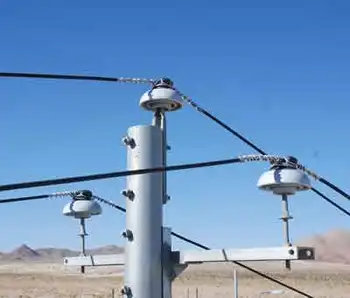Was deregulation beneficial?
Some of the highest electricity prices in the nation.
Utilities accused of spending lavishly and passing the cost to hapless consumers in rate increases.
Many forget the setting that led Pennsylvania and other states to restructure the retail electric industry in the early 1990s, a move that is now being questioned as electricity bills are expected to increase more than 30 percent with only modest competition for residential customers.
"The idea of deregulation is attractive - more competition, increased efficiency, and lower prices, but unfortunately this is often not the case," said Catherine Ngo, field organizer for the left-leaning Pennsylvania Public Interest Research Group.
"When deregulated with a profit motive, the incentive is to sell the most product they can, and they won't be turning to cost savings measures and smart energy usage," she said.
Utilities used to be monoliths and monopolies - generation, transmission and distribution all in one company that owned everything from the power plant to the power meter in the geographic service area. In exchange for pledging to serve everyone, utilities worked as a regulated monopoly with the ability to recoup reasonable costs plus profit through regulated rates.
Pricey nuclear power plants killed that model and hastened the move toward deregulation. The vertically integrated monopolies were required to build their own generation, enough to meet demand for the hottest summer day and coldest winter night.
Nuclear power plants, like the Susquehanna nuclear power plant in Salem Township, Luzerne County, ended up costing nearly twice as much as projected, the price tag going from $2 billion to $4.1 billion. The nation had a glut of electricity, yet prices did not go down.
Unlike other private industries, utilities were just about guaranteed to recoup their costs in rates. The "regulatory compact" to keep the lights on meant the costs of just about everything utilities spend on - fleets of trucks, new employees' salaries, even nuclear power plants - were passed on to ratepayers after review and approval from the Public Utility Commission. Rates were based on a cost-plus formula - the total cost of building power plants and wires - the so-called "base" - depreciated over time, plus an additional expense and profit calculated from that base. Utility critics and economists say that system encourages companies to constantly build and replace and add, since more spending increases the base, which allows more gross profit.
So when a $2 billion power plant ended up costing $4.1 billion, the cost was shouldered by electricity customers, and resulted in more profits for the company.
"The feeling was that utilities had no incentive to encourage conservation and no incentive to limit construction or investment," said PUC Chairman James Cawley, who served as a commissioner in the 1980s and returned in 2005. "When utilities did build, cost overruns were more likely to be borne by ratepayers. The goal of restructuring was to get the risk of construction, maintenance and operation of these plants off the backs of captive customers and on the backs of investors."
By the early 1990s, Pennsylvanians paid electricity rates 15 percent greater than the national average. Meanwhile, the electric transmission grid was becoming more robust and interconnected, creating the opportunity to buy power from greater distances. The Federal Power Act of 1992 required transmission lines, including those owned by PPL, to become "common carriers," like phone lines, to carry anyone's power. PPL began selling extra power to out-of-state-buyers. It was possible for a customer in Nanticoke to purchase inexpensive, efficiently produced electricity generated in Ohio, but the regulatory system didn't allow it.
"There was a feeling that if electric utilities were given the chance to sell their power elsewhere, then customers should be given the chance to buy their power from elsewhere," Mr. Cawley said. "The industrial customers led the charge, because even as they were paying 1.5 to 2 cents per kilowatt-hour, they could get it cheaper."
The Legislature and the public had had enough. Utilities didn't need a monopoly on generation, lawmakers concluded. Transmission and distribution - the poles, wires and towers - on the other hand, were a natural monopoly. But power plants were burdening ratepayers with their costly operations.
In December 1996, Gov. Tom Ridge signed the Electricity Generation Customer Choice and Competition Act. Among its requirements:
• Utilities were required to sell off their generation plants or spin them off in distinct divisions, as PPL did. Their operations, costs and risks would no longer be borne by ratepayers, but rather by the company and its shareholders. The cost of power generation would no longer be regulated and no longer guaranteed to make a profit. The market would determine prices.
• Customers would have to pay utilities' so-called "stranded costs" - money utilities spent under regulation for assets such as power plants that were worth less in a restructured market. This added about 2 cents to every kilowatt-hour of power for a decade.
• To prevent gouging of customers who don't pick a competitive electricity provider, generation rate caps were imposed in PPL's service area for 10 years, after which prices would be determined by the market. The utility, now just a "poles and wires company," would be the "provider of last resort." Transmission and distribution rates were frozen until 2004. Generation rates were frozen until December 31. Blended, the capped rates were between 9 and 10 cents per kilowatt-hour, about half of which was generation.
• PPL agreed to cut rates by 4 percent for one year. Bills began to break out the cost of the transmission, distribution and generation.
Everyone remained a customer of the regulated utility, which would still transmit and distribute power. But customers could buy their power from anyone offering the best deal. Deregulated and competitive, the market would reward efficient generators and costs would come down.
"We restructured to put more competitive pressure on the utilities," said state Consumer Advocate Irwin "Sonny" Popowsky. "Competitive pressure would be stronger than whatever pressure the PUC had."
At about 5 cents per kilowatt-hour for generation, no one imagined market prices would go above the capped rates. They did, starting in late 1999. The cost of other forms of energy skyrocketed. In that decade, electricity rates increased about 6 percent, a fraction of the cost of other forms of energy. A gallon of gasoline surged 80 percent. Natural gas increased even more, 88 percent, although it has since fallen. Coal prices almost doubled. Rather than a bulwark against gouging, the capped rate became a bargain.
The half-million or so Pennsylvanians who did switch energy providers began to come back to PPL as the provider of last resort, seeking out the protection of capped rates.
Those energy providers couldn't compete with the now artificially low-capped rates and they pulled out of the state. Some just went out of business.
Big industrial users have been able to find deals outside the incumbent utility. But no company was able to beat capped residential rates that are 25 percent below the regional average.
As caps are lifted, competition is returning. In Pittsburgh, more than half the customers buy their power from one of 14 supply companies. In Penn Power's territory, one retail provider is offering 33 percent savings compared to Penn Power's default rate. PPL's electricity purchase, through six acquisitions spread out over two years, resulted in noncompetitive prices for consumers that would hit customers who do not pick a provider with a 30.4 percent increase in their bill. The price for generation is nearly doubling, from the capped 5 cents to about 9 cents per kilowatt-hour.
Market-based energy prices last summer were pointing toward as much as a 50 percent increase in bills. But power prices fell. As of October, the most recent information available, energy was trading at about 18.3 percent more than the capped rate, considerably less than PPL's expected rate increase, opening the door to a handful of providers able to offer better rates.
PPL Electric Utilities doesn't care if everyone shops for a better deal. Under the restructuring, they must buy the power and pass through the cost without profit. The utility makes no profit. It makes money delivering power, which is still a state-regulated activity.
"We are now UPS - we deliver packages, we don't care where the boxes are from," said PPL spokesman George Lewis. "Customers will see competitive offers and we hope they will take advantage of them."
Related News

Covid-19 puts brake on Turkey’s solar sector
ANKARA - The decision by the Turkish Energy Market Regulatory Authority to halt part of the system of processing net metering applications risks bringing the only vibrant segment of the nation’s solar industry to a grinding halt.
The regulator has suspended monthly meetings of the committee which makes technical evaluations of net metering applications, citing concerns about the spread of Covid-19.
The availability of electricity bill credits for net-metering-approved households which inject surplus power into the grid has seen the rooftop projects the scheme is typically associated with remain the only source of new solar generation capacity in Turkey of late.
However the…





